HI6028 Taxation Assignment
VerifiedAdded on 2019/10/30
|14
|2884
|103
Homework Assignment
AI Summary
This document presents solved solutions for a HI6028 Taxation Theory, Practice & Law assignment. It addresses several tax-related scenarios, including capital gains tax calculations, fringe benefits tax on employee loans, tax implications of rental property co-ownership, tax avoidance schemes, and the tax treatment of timber disposal. Each question follows a structured approach: identifying the issue, outlining relevant regulations and legal provisions, applying these provisions to the specific case, and drawing a conclusion. The solutions cite relevant Australian tax legislation, rulings (like TR 93/32 and TR 95/6), and academic sources. The assignment demonstrates a comprehensive understanding of Australian taxation principles and their practical application in various situations.
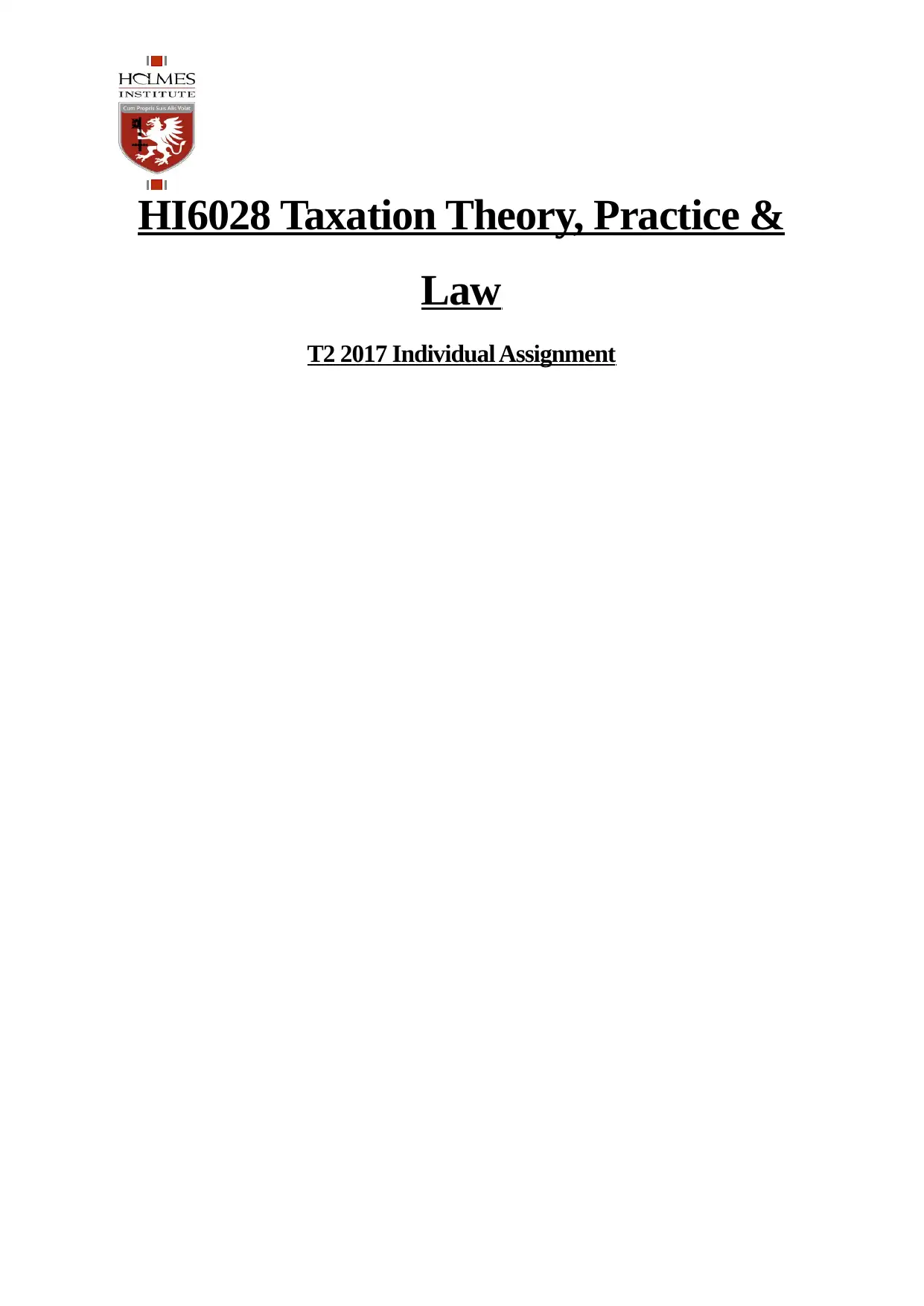
HI6028 Taxation Theory, Practice &
Law
T2 2017 Individual Assignment
Law
T2 2017 Individual Assignment
Paraphrase This Document
Need a fresh take? Get an instant paraphrase of this document with our AI Paraphraser

TABLE OF CONTENTS
Question 1..................................................................................................................................4
Issue........................................................................................................................................4
Regulations.............................................................................................................................4
Application of legal provisions..............................................................................................4
Conclusion..............................................................................................................................5
References..............................................................................................................................5
Question 2..................................................................................................................................7
Issue........................................................................................................................................7
Regulations.............................................................................................................................7
Application of legal provisions..............................................................................................7
Conclusion..............................................................................................................................8
References..............................................................................................................................8
Question 3..................................................................................................................................9
Issue........................................................................................................................................9
Regulations.............................................................................................................................9
Application of legal provisions............................................................................................10
Conclusion............................................................................................................................10
References............................................................................................................................10
Question 4................................................................................................................................12
Description of issues............................................................................................................12
Legal provisions...................................................................................................................12
Application of described provisions.....................................................................................12
Conclusion............................................................................................................................12
References............................................................................................................................13
Question 1..................................................................................................................................4
Issue........................................................................................................................................4
Regulations.............................................................................................................................4
Application of legal provisions..............................................................................................4
Conclusion..............................................................................................................................5
References..............................................................................................................................5
Question 2..................................................................................................................................7
Issue........................................................................................................................................7
Regulations.............................................................................................................................7
Application of legal provisions..............................................................................................7
Conclusion..............................................................................................................................8
References..............................................................................................................................8
Question 3..................................................................................................................................9
Issue........................................................................................................................................9
Regulations.............................................................................................................................9
Application of legal provisions............................................................................................10
Conclusion............................................................................................................................10
References............................................................................................................................10
Question 4................................................................................................................................12
Description of issues............................................................................................................12
Legal provisions...................................................................................................................12
Application of described provisions.....................................................................................12
Conclusion............................................................................................................................12
References............................................................................................................................13

Question 5................................................................................................................................14
Issue......................................................................................................................................14
Regulations...........................................................................................................................14
Application of legal provisions............................................................................................15
Conclusion............................................................................................................................15
Reference..............................................................................................................................15
Issue......................................................................................................................................14
Regulations...........................................................................................................................14
Application of legal provisions............................................................................................15
Conclusion............................................................................................................................15
Reference..............................................................................................................................15
⊘ This is a preview!⊘
Do you want full access?
Subscribe today to unlock all pages.

Trusted by 1+ million students worldwide
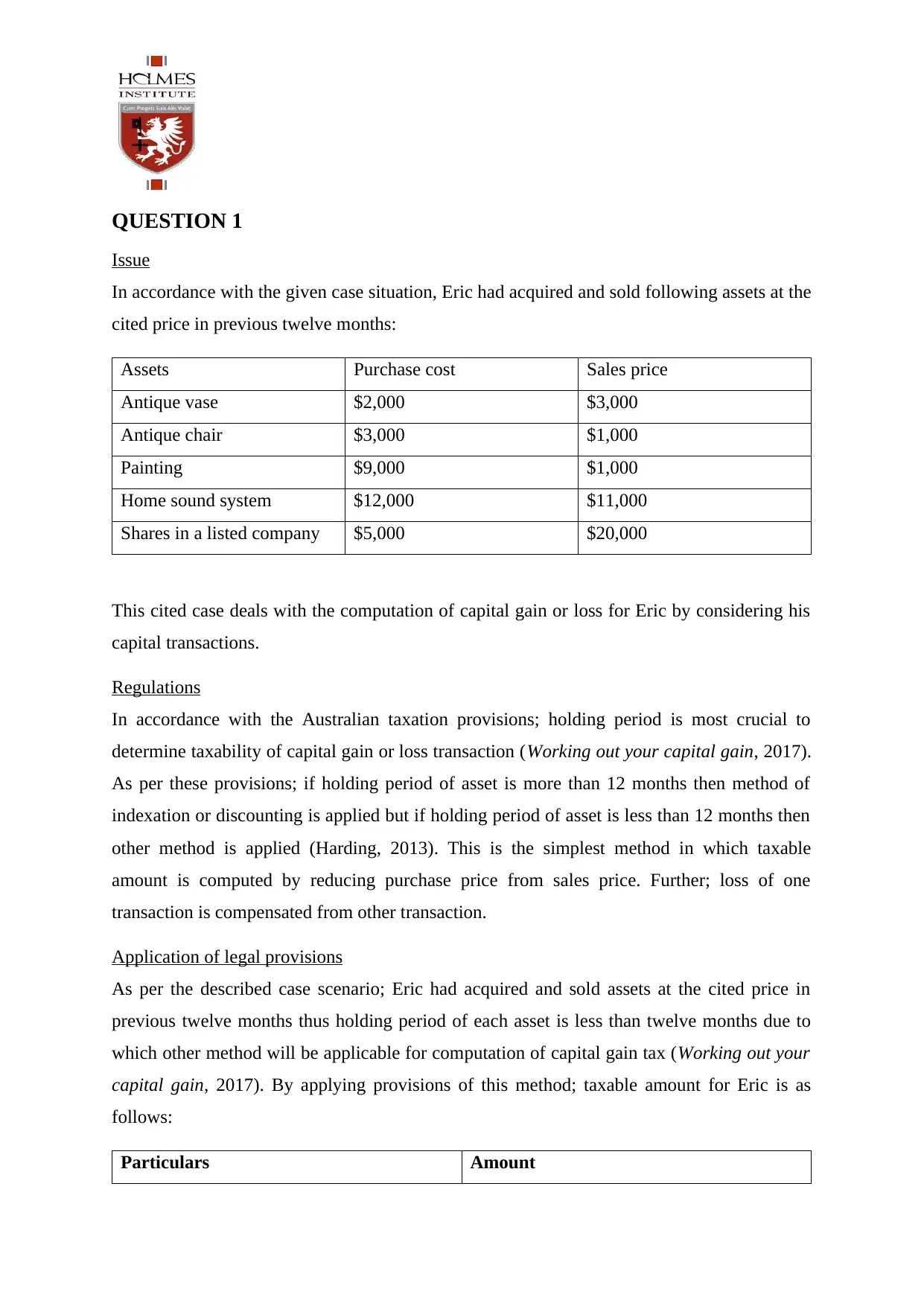
QUESTION 1
Issue
In accordance with the given case situation, Eric had acquired and sold following assets at the
cited price in previous twelve months:
Assets Purchase cost Sales price
Antique vase $2,000 $3,000
Antique chair $3,000 $1,000
Painting $9,000 $1,000
Home sound system $12,000 $11,000
Shares in a listed company $5,000 $20,000
This cited case deals with the computation of capital gain or loss for Eric by considering his
capital transactions.
Regulations
In accordance with the Australian taxation provisions; holding period is most crucial to
determine taxability of capital gain or loss transaction (Working out your capital gain, 2017).
As per these provisions; if holding period of asset is more than 12 months then method of
indexation or discounting is applied but if holding period of asset is less than 12 months then
other method is applied (Harding, 2013). This is the simplest method in which taxable
amount is computed by reducing purchase price from sales price. Further; loss of one
transaction is compensated from other transaction.
Application of legal provisions
As per the described case scenario; Eric had acquired and sold assets at the cited price in
previous twelve months thus holding period of each asset is less than twelve months due to
which other method will be applicable for computation of capital gain tax (Working out your
capital gain, 2017). By applying provisions of this method; taxable amount for Eric is as
follows:
Particulars Amount
Issue
In accordance with the given case situation, Eric had acquired and sold following assets at the
cited price in previous twelve months:
Assets Purchase cost Sales price
Antique vase $2,000 $3,000
Antique chair $3,000 $1,000
Painting $9,000 $1,000
Home sound system $12,000 $11,000
Shares in a listed company $5,000 $20,000
This cited case deals with the computation of capital gain or loss for Eric by considering his
capital transactions.
Regulations
In accordance with the Australian taxation provisions; holding period is most crucial to
determine taxability of capital gain or loss transaction (Working out your capital gain, 2017).
As per these provisions; if holding period of asset is more than 12 months then method of
indexation or discounting is applied but if holding period of asset is less than 12 months then
other method is applied (Harding, 2013). This is the simplest method in which taxable
amount is computed by reducing purchase price from sales price. Further; loss of one
transaction is compensated from other transaction.
Application of legal provisions
As per the described case scenario; Eric had acquired and sold assets at the cited price in
previous twelve months thus holding period of each asset is less than twelve months due to
which other method will be applicable for computation of capital gain tax (Working out your
capital gain, 2017). By applying provisions of this method; taxable amount for Eric is as
follows:
Particulars Amount
Paraphrase This Document
Need a fresh take? Get an instant paraphrase of this document with our AI Paraphraser
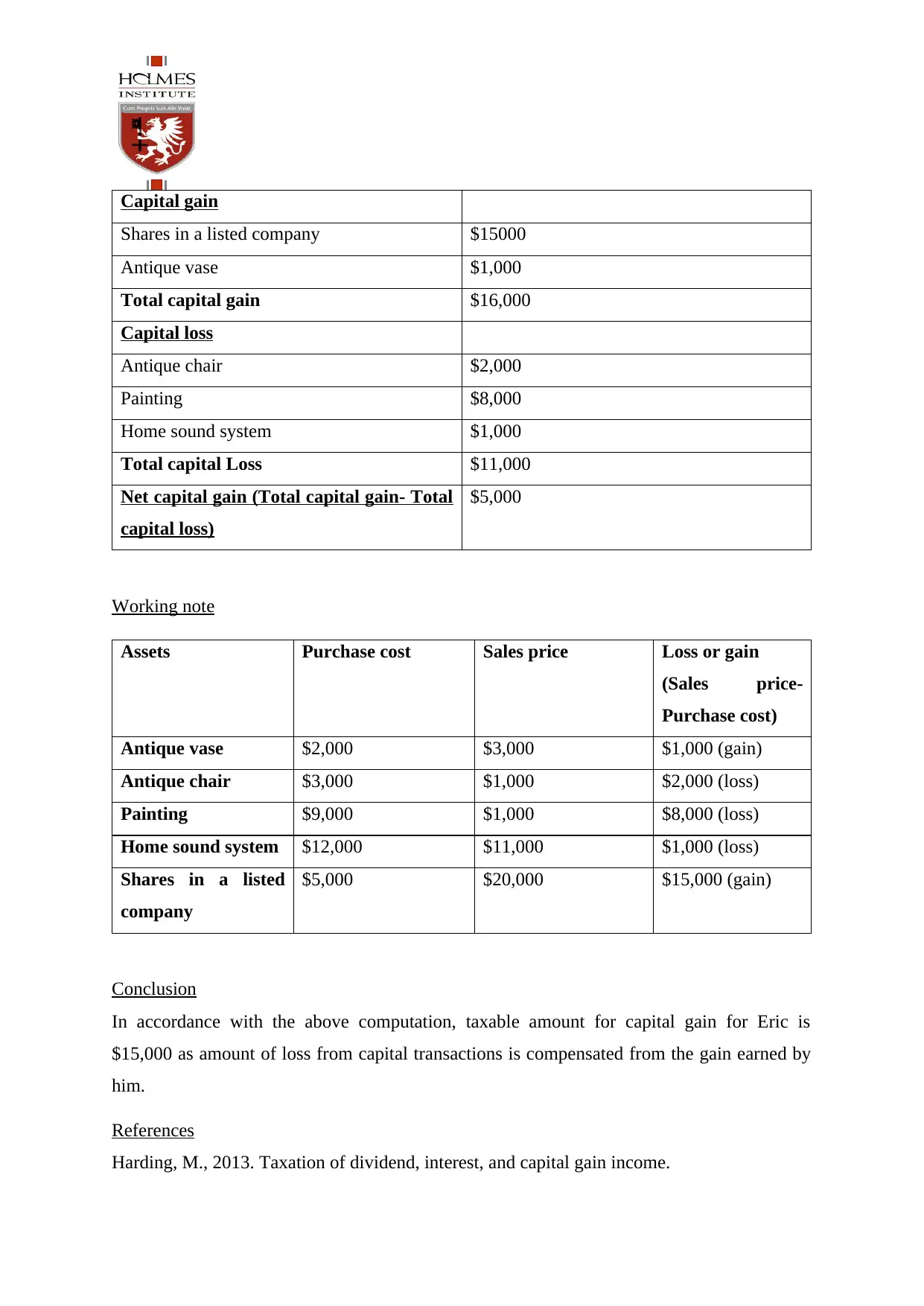
Capital gain
Shares in a listed company $15000
Antique vase $1,000
Total capital gain $16,000
Capital loss
Antique chair $2,000
Painting $8,000
Home sound system $1,000
Total capital Loss $11,000
Net capital gain (Total capital gain- Total
capital loss)
$5,000
Working note
Assets Purchase cost Sales price Loss or gain
(Sales price-
Purchase cost)
Antique vase $2,000 $3,000 $1,000 (gain)
Antique chair $3,000 $1,000 $2,000 (loss)
Painting $9,000 $1,000 $8,000 (loss)
Home sound system $12,000 $11,000 $1,000 (loss)
Shares in a listed
company
$5,000 $20,000 $15,000 (gain)
Conclusion
In accordance with the above computation, taxable amount for capital gain for Eric is
$15,000 as amount of loss from capital transactions is compensated from the gain earned by
him.
References
Harding, M., 2013. Taxation of dividend, interest, and capital gain income.
Shares in a listed company $15000
Antique vase $1,000
Total capital gain $16,000
Capital loss
Antique chair $2,000
Painting $8,000
Home sound system $1,000
Total capital Loss $11,000
Net capital gain (Total capital gain- Total
capital loss)
$5,000
Working note
Assets Purchase cost Sales price Loss or gain
(Sales price-
Purchase cost)
Antique vase $2,000 $3,000 $1,000 (gain)
Antique chair $3,000 $1,000 $2,000 (loss)
Painting $9,000 $1,000 $8,000 (loss)
Home sound system $12,000 $11,000 $1,000 (loss)
Shares in a listed
company
$5,000 $20,000 $15,000 (gain)
Conclusion
In accordance with the above computation, taxable amount for capital gain for Eric is
$15,000 as amount of loss from capital transactions is compensated from the gain earned by
him.
References
Harding, M., 2013. Taxation of dividend, interest, and capital gain income.

Working out your capital gain. 2017. [Online]. Available through <
https://www.ato.gov.au/General/Capital-gains-tax/Working-out-your-capital-gain-or-loss/
Working-out-your-capital-gain/>. [Accessed on 16th September 2017].
https://www.ato.gov.au/General/Capital-gains-tax/Working-out-your-capital-gain-or-loss/
Working-out-your-capital-gain/>. [Accessed on 16th September 2017].
⊘ This is a preview!⊘
Do you want full access?
Subscribe today to unlock all pages.

Trusted by 1+ million students worldwide
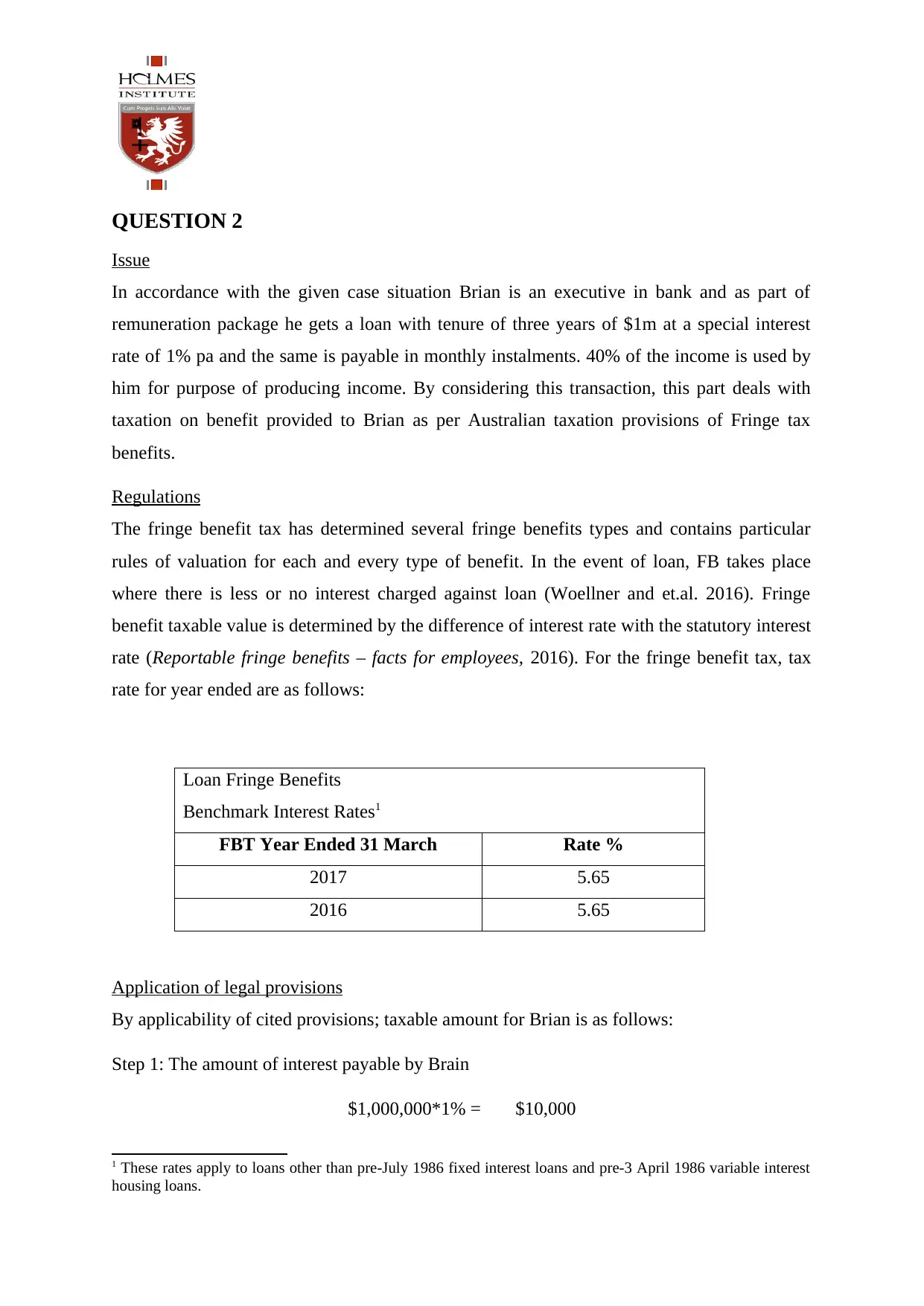
QUESTION 2
Issue
In accordance with the given case situation Brian is an executive in bank and as part of
remuneration package he gets a loan with tenure of three years of $1m at a special interest
rate of 1% pa and the same is payable in monthly instalments. 40% of the income is used by
him for purpose of producing income. By considering this transaction, this part deals with
taxation on benefit provided to Brian as per Australian taxation provisions of Fringe tax
benefits.
Regulations
The fringe benefit tax has determined several fringe benefits types and contains particular
rules of valuation for each and every type of benefit. In the event of loan, FB takes place
where there is less or no interest charged against loan (Woellner and et.al. 2016). Fringe
benefit taxable value is determined by the difference of interest rate with the statutory interest
rate (Reportable fringe benefits – facts for employees, 2016). For the fringe benefit tax, tax
rate for year ended are as follows:
Loan Fringe Benefits
Benchmark Interest Rates1
FBT Year Ended 31 March Rate %
2017 5.65
2016 5.65
Application of legal provisions
By applicability of cited provisions; taxable amount for Brian is as follows:
Step 1: The amount of interest payable by Brain
$1,000,000*1% = $10,000
1 These rates apply to loans other than pre-July 1986 fixed interest loans and pre-3 April 1986 variable interest
housing loans.
Issue
In accordance with the given case situation Brian is an executive in bank and as part of
remuneration package he gets a loan with tenure of three years of $1m at a special interest
rate of 1% pa and the same is payable in monthly instalments. 40% of the income is used by
him for purpose of producing income. By considering this transaction, this part deals with
taxation on benefit provided to Brian as per Australian taxation provisions of Fringe tax
benefits.
Regulations
The fringe benefit tax has determined several fringe benefits types and contains particular
rules of valuation for each and every type of benefit. In the event of loan, FB takes place
where there is less or no interest charged against loan (Woellner and et.al. 2016). Fringe
benefit taxable value is determined by the difference of interest rate with the statutory interest
rate (Reportable fringe benefits – facts for employees, 2016). For the fringe benefit tax, tax
rate for year ended are as follows:
Loan Fringe Benefits
Benchmark Interest Rates1
FBT Year Ended 31 March Rate %
2017 5.65
2016 5.65
Application of legal provisions
By applicability of cited provisions; taxable amount for Brian is as follows:
Step 1: The amount of interest payable by Brain
$1,000,000*1% = $10,000
1 These rates apply to loans other than pre-July 1986 fixed interest loans and pre-3 April 1986 variable interest
housing loans.
Paraphrase This Document
Need a fresh take? Get an instant paraphrase of this document with our AI Paraphraser
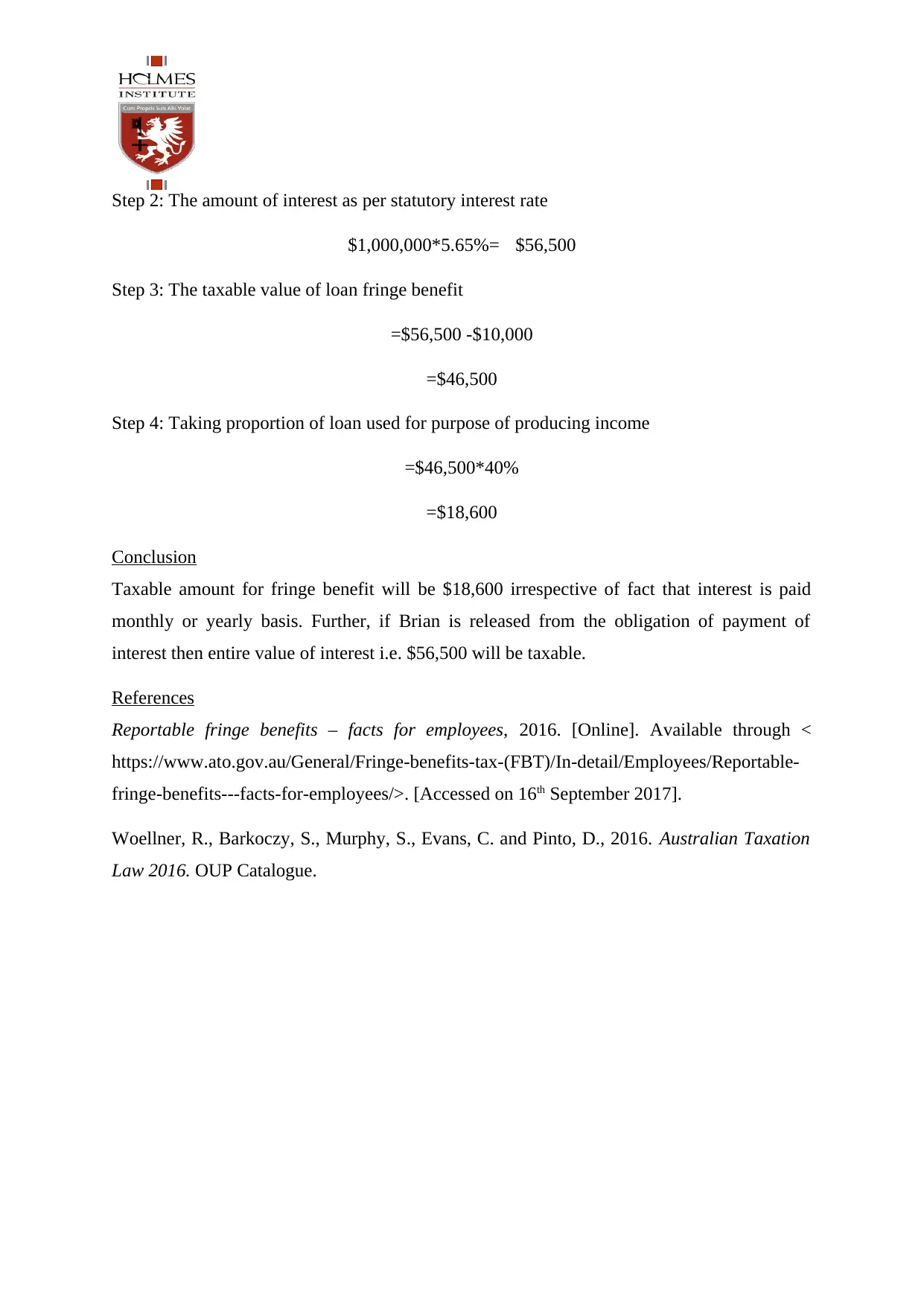
Step 2: The amount of interest as per statutory interest rate
$1,000,000*5.65%= $56,500
Step 3: The taxable value of loan fringe benefit
=$56,500 -$10,000
=$46,500
Step 4: Taking proportion of loan used for purpose of producing income
=$46,500*40%
=$18,600
Conclusion
Taxable amount for fringe benefit will be $18,600 irrespective of fact that interest is paid
monthly or yearly basis. Further, if Brian is released from the obligation of payment of
interest then entire value of interest i.e. $56,500 will be taxable.
References
Reportable fringe benefits – facts for employees, 2016. [Online]. Available through <
https://www.ato.gov.au/General/Fringe-benefits-tax-(FBT)/In-detail/Employees/Reportable-
fringe-benefits---facts-for-employees/>. [Accessed on 16th September 2017].
Woellner, R., Barkoczy, S., Murphy, S., Evans, C. and Pinto, D., 2016. Australian Taxation
Law 2016. OUP Catalogue.
$1,000,000*5.65%= $56,500
Step 3: The taxable value of loan fringe benefit
=$56,500 -$10,000
=$46,500
Step 4: Taking proportion of loan used for purpose of producing income
=$46,500*40%
=$18,600
Conclusion
Taxable amount for fringe benefit will be $18,600 irrespective of fact that interest is paid
monthly or yearly basis. Further, if Brian is released from the obligation of payment of
interest then entire value of interest i.e. $56,500 will be taxable.
References
Reportable fringe benefits – facts for employees, 2016. [Online]. Available through <
https://www.ato.gov.au/General/Fringe-benefits-tax-(FBT)/In-detail/Employees/Reportable-
fringe-benefits---facts-for-employees/>. [Accessed on 16th September 2017].
Woellner, R., Barkoczy, S., Murphy, S., Evans, C. and Pinto, D., 2016. Australian Taxation
Law 2016. OUP Catalogue.
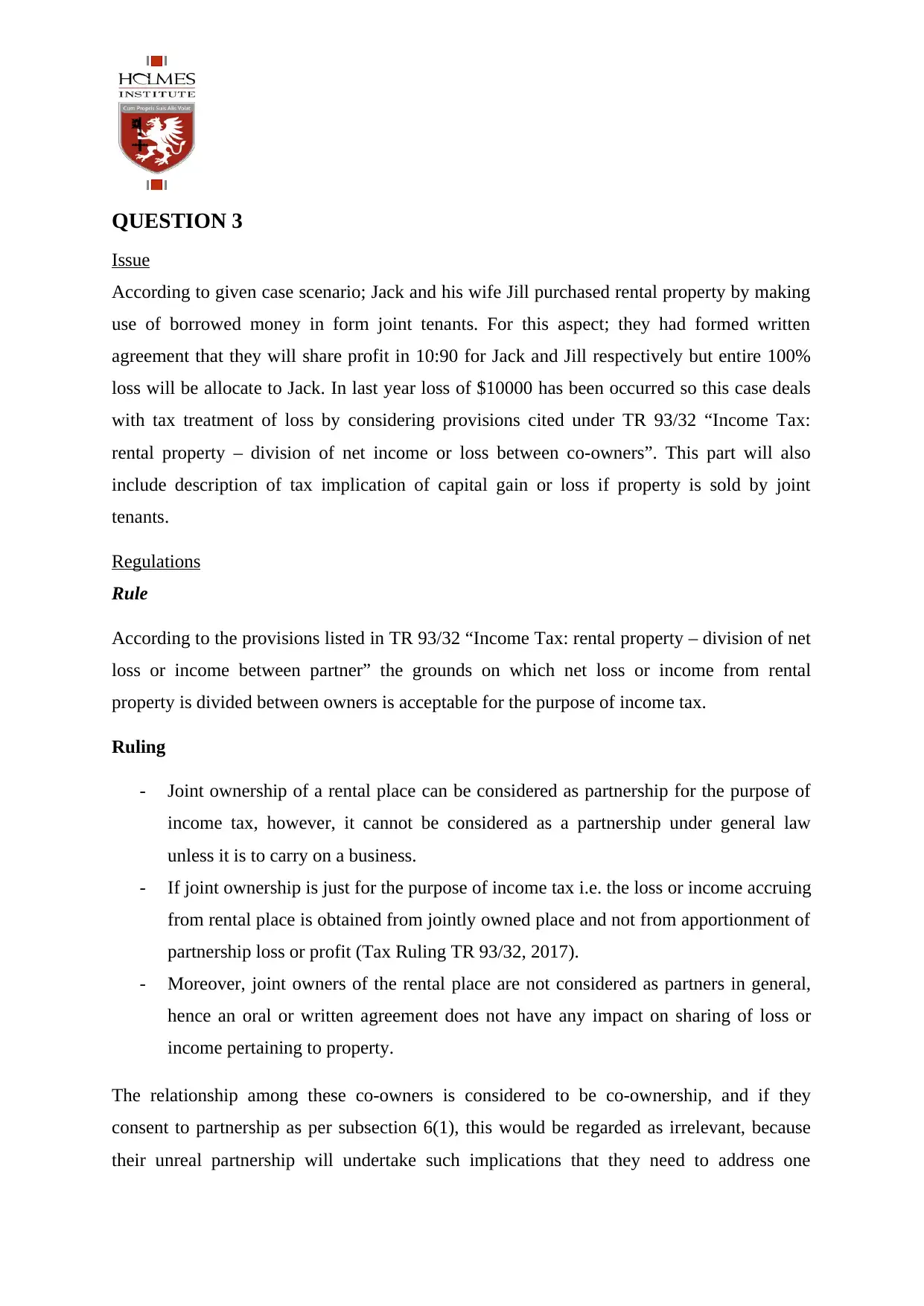
QUESTION 3
Issue
According to given case scenario; Jack and his wife Jill purchased rental property by making
use of borrowed money in form joint tenants. For this aspect; they had formed written
agreement that they will share profit in 10:90 for Jack and Jill respectively but entire 100%
loss will be allocate to Jack. In last year loss of $10000 has been occurred so this case deals
with tax treatment of loss by considering provisions cited under TR 93/32 “Income Tax:
rental property – division of net income or loss between co-owners”. This part will also
include description of tax implication of capital gain or loss if property is sold by joint
tenants.
Regulations
Rule
According to the provisions listed in TR 93/32 “Income Tax: rental property – division of net
loss or income between partner” the grounds on which net loss or income from rental
property is divided between owners is acceptable for the purpose of income tax.
Ruling
- Joint ownership of a rental place can be considered as partnership for the purpose of
income tax, however, it cannot be considered as a partnership under general law
unless it is to carry on a business.
- If joint ownership is just for the purpose of income tax i.e. the loss or income accruing
from rental place is obtained from jointly owned place and not from apportionment of
partnership loss or profit (Tax Ruling TR 93/32, 2017).
- Moreover, joint owners of the rental place are not considered as partners in general,
hence an oral or written agreement does not have any impact on sharing of loss or
income pertaining to property.
The relationship among these co-owners is considered to be co-ownership, and if they
consent to partnership as per subsection 6(1), this would be regarded as irrelevant, because
their unreal partnership will undertake such implications that they need to address one
Issue
According to given case scenario; Jack and his wife Jill purchased rental property by making
use of borrowed money in form joint tenants. For this aspect; they had formed written
agreement that they will share profit in 10:90 for Jack and Jill respectively but entire 100%
loss will be allocate to Jack. In last year loss of $10000 has been occurred so this case deals
with tax treatment of loss by considering provisions cited under TR 93/32 “Income Tax:
rental property – division of net income or loss between co-owners”. This part will also
include description of tax implication of capital gain or loss if property is sold by joint
tenants.
Regulations
Rule
According to the provisions listed in TR 93/32 “Income Tax: rental property – division of net
loss or income between partner” the grounds on which net loss or income from rental
property is divided between owners is acceptable for the purpose of income tax.
Ruling
- Joint ownership of a rental place can be considered as partnership for the purpose of
income tax, however, it cannot be considered as a partnership under general law
unless it is to carry on a business.
- If joint ownership is just for the purpose of income tax i.e. the loss or income accruing
from rental place is obtained from jointly owned place and not from apportionment of
partnership loss or profit (Tax Ruling TR 93/32, 2017).
- Moreover, joint owners of the rental place are not considered as partners in general,
hence an oral or written agreement does not have any impact on sharing of loss or
income pertaining to property.
The relationship among these co-owners is considered to be co-ownership, and if they
consent to partnership as per subsection 6(1), this would be regarded as irrelevant, because
their unreal partnership will undertake such implications that they need to address one
⊘ This is a preview!⊘
Do you want full access?
Subscribe today to unlock all pages.

Trusted by 1+ million students worldwide
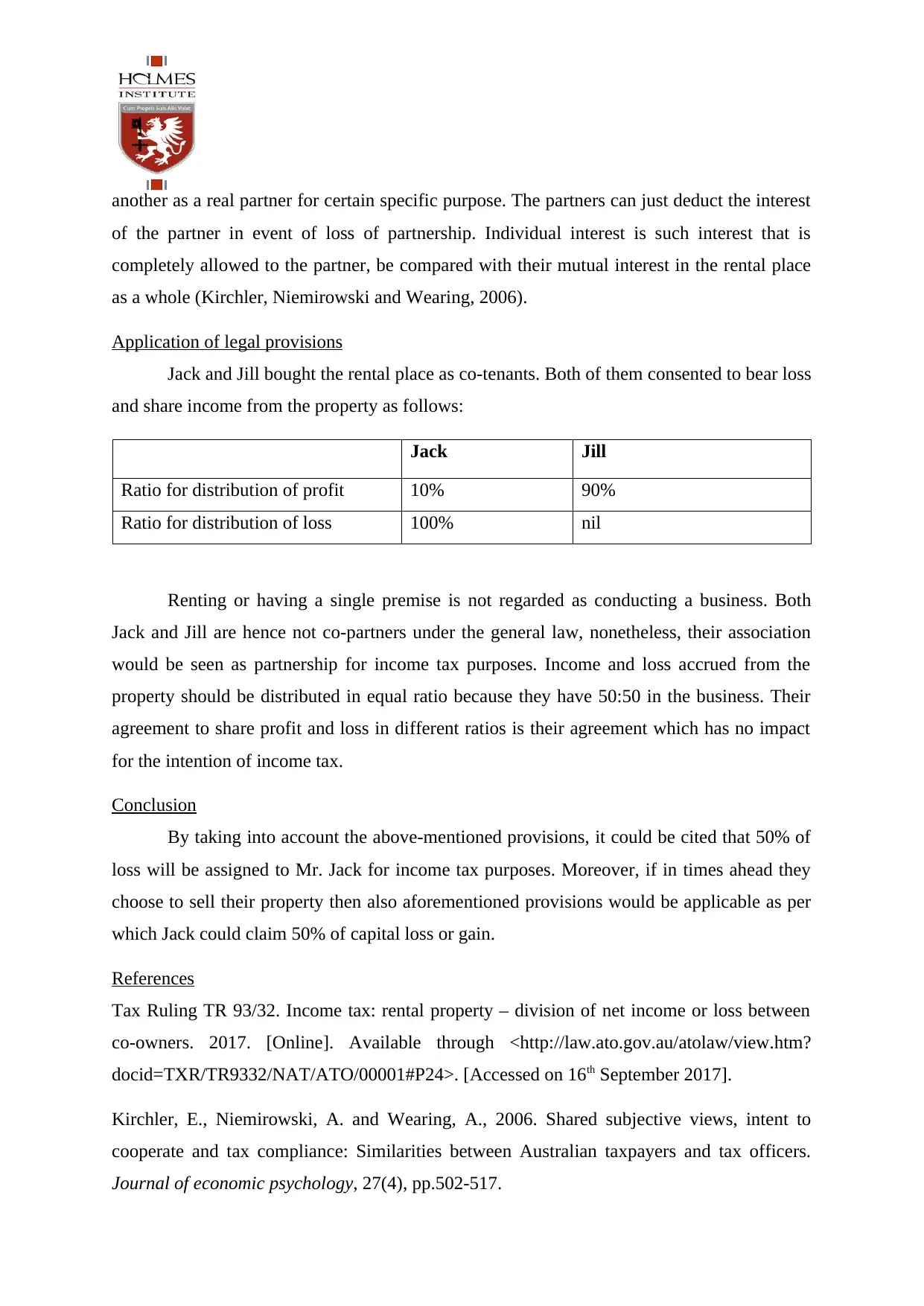
another as a real partner for certain specific purpose. The partners can just deduct the interest
of the partner in event of loss of partnership. Individual interest is such interest that is
completely allowed to the partner, be compared with their mutual interest in the rental place
as a whole (Kirchler, Niemirowski and Wearing, 2006).
Application of legal provisions
Jack and Jill bought the rental place as co-tenants. Both of them consented to bear loss
and share income from the property as follows:
Jack Jill
Ratio for distribution of profit 10% 90%
Ratio for distribution of loss 100% nil
Renting or having a single premise is not regarded as conducting a business. Both
Jack and Jill are hence not co-partners under the general law, nonetheless, their association
would be seen as partnership for income tax purposes. Income and loss accrued from the
property should be distributed in equal ratio because they have 50:50 in the business. Their
agreement to share profit and loss in different ratios is their agreement which has no impact
for the intention of income tax.
Conclusion
By taking into account the above-mentioned provisions, it could be cited that 50% of
loss will be assigned to Mr. Jack for income tax purposes. Moreover, if in times ahead they
choose to sell their property then also aforementioned provisions would be applicable as per
which Jack could claim 50% of capital loss or gain.
References
Tax Ruling TR 93/32. Income tax: rental property – division of net income or loss between
co-owners. 2017. [Online]. Available through <http://law.ato.gov.au/atolaw/view.htm?
docid=TXR/TR9332/NAT/ATO/00001#P24>. [Accessed on 16th September 2017].
Kirchler, E., Niemirowski, A. and Wearing, A., 2006. Shared subjective views, intent to
cooperate and tax compliance: Similarities between Australian taxpayers and tax officers.
Journal of economic psychology, 27(4), pp.502-517.
of the partner in event of loss of partnership. Individual interest is such interest that is
completely allowed to the partner, be compared with their mutual interest in the rental place
as a whole (Kirchler, Niemirowski and Wearing, 2006).
Application of legal provisions
Jack and Jill bought the rental place as co-tenants. Both of them consented to bear loss
and share income from the property as follows:
Jack Jill
Ratio for distribution of profit 10% 90%
Ratio for distribution of loss 100% nil
Renting or having a single premise is not regarded as conducting a business. Both
Jack and Jill are hence not co-partners under the general law, nonetheless, their association
would be seen as partnership for income tax purposes. Income and loss accrued from the
property should be distributed in equal ratio because they have 50:50 in the business. Their
agreement to share profit and loss in different ratios is their agreement which has no impact
for the intention of income tax.
Conclusion
By taking into account the above-mentioned provisions, it could be cited that 50% of
loss will be assigned to Mr. Jack for income tax purposes. Moreover, if in times ahead they
choose to sell their property then also aforementioned provisions would be applicable as per
which Jack could claim 50% of capital loss or gain.
References
Tax Ruling TR 93/32. Income tax: rental property – division of net income or loss between
co-owners. 2017. [Online]. Available through <http://law.ato.gov.au/atolaw/view.htm?
docid=TXR/TR9332/NAT/ATO/00001#P24>. [Accessed on 16th September 2017].
Kirchler, E., Niemirowski, A. and Wearing, A., 2006. Shared subjective views, intent to
cooperate and tax compliance: Similarities between Australian taxpayers and tax officers.
Journal of economic psychology, 27(4), pp.502-517.
Paraphrase This Document
Need a fresh take? Get an instant paraphrase of this document with our AI Paraphraser

QUESTION 4
Description of issues
As per the facts cited in the case of Duke of Westminster v CIR 19 TC 490, Duke had assured
to pay the additional sum to gardener if they give extra services. The deed had taken place in
written format. Nonetheless, this deed for created with the sole objective to receive a
deduction for the purpose of tax evasion.
Legal provisions
Principle
In the concerned situation of Duke of Westminster v CIR 19 TC 490, the ruling was that
every individual is permissible to manage their affairs, because the tax chargeable according
to the suitable action would be minimum. This ruling is preferred by many people, and they
would prefer seeing the execution of this judgment on a continuous basis, subsequent to the
introduction of any normal anti-avoidance law in Australia (Pinto, 2012).
Application of described provisions
Relevance in present scenario
In the last year, the constitution has established some provisions that requires advisors to
intimate the HMRC about any scheme which can result in tax evasion. Nonetheless, this
would not be viewed all over the board, and it remains to be observed regarding what type of
actions would be taken when getting such notifications. It may be seen in the settlement when
such rulings will serve as an originator to the setting of new provisions instead of more
extensive current rulings (Mete, Dick and Moerman, 2010).
Conclusion
Lord Wilberforce identified that although the ruling of Duke of Westminster prevented the
court from noticing the actual transaction to some alleged basic substance, it would not
“please the court to see the document in blinkers, not accessible from all contexts to which it
really belongs’.
The court should identify the legal nature of the transaction through which it needs to make
attachment of a tax or a tax outcome and in case it results as a mixture or series of
Description of issues
As per the facts cited in the case of Duke of Westminster v CIR 19 TC 490, Duke had assured
to pay the additional sum to gardener if they give extra services. The deed had taken place in
written format. Nonetheless, this deed for created with the sole objective to receive a
deduction for the purpose of tax evasion.
Legal provisions
Principle
In the concerned situation of Duke of Westminster v CIR 19 TC 490, the ruling was that
every individual is permissible to manage their affairs, because the tax chargeable according
to the suitable action would be minimum. This ruling is preferred by many people, and they
would prefer seeing the execution of this judgment on a continuous basis, subsequent to the
introduction of any normal anti-avoidance law in Australia (Pinto, 2012).
Application of described provisions
Relevance in present scenario
In the last year, the constitution has established some provisions that requires advisors to
intimate the HMRC about any scheme which can result in tax evasion. Nonetheless, this
would not be viewed all over the board, and it remains to be observed regarding what type of
actions would be taken when getting such notifications. It may be seen in the settlement when
such rulings will serve as an originator to the setting of new provisions instead of more
extensive current rulings (Mete, Dick and Moerman, 2010).
Conclusion
Lord Wilberforce identified that although the ruling of Duke of Westminster prevented the
court from noticing the actual transaction to some alleged basic substance, it would not
“please the court to see the document in blinkers, not accessible from all contexts to which it
really belongs’.
The court should identify the legal nature of the transaction through which it needs to make
attachment of a tax or a tax outcome and in case it results as a mixture or series of
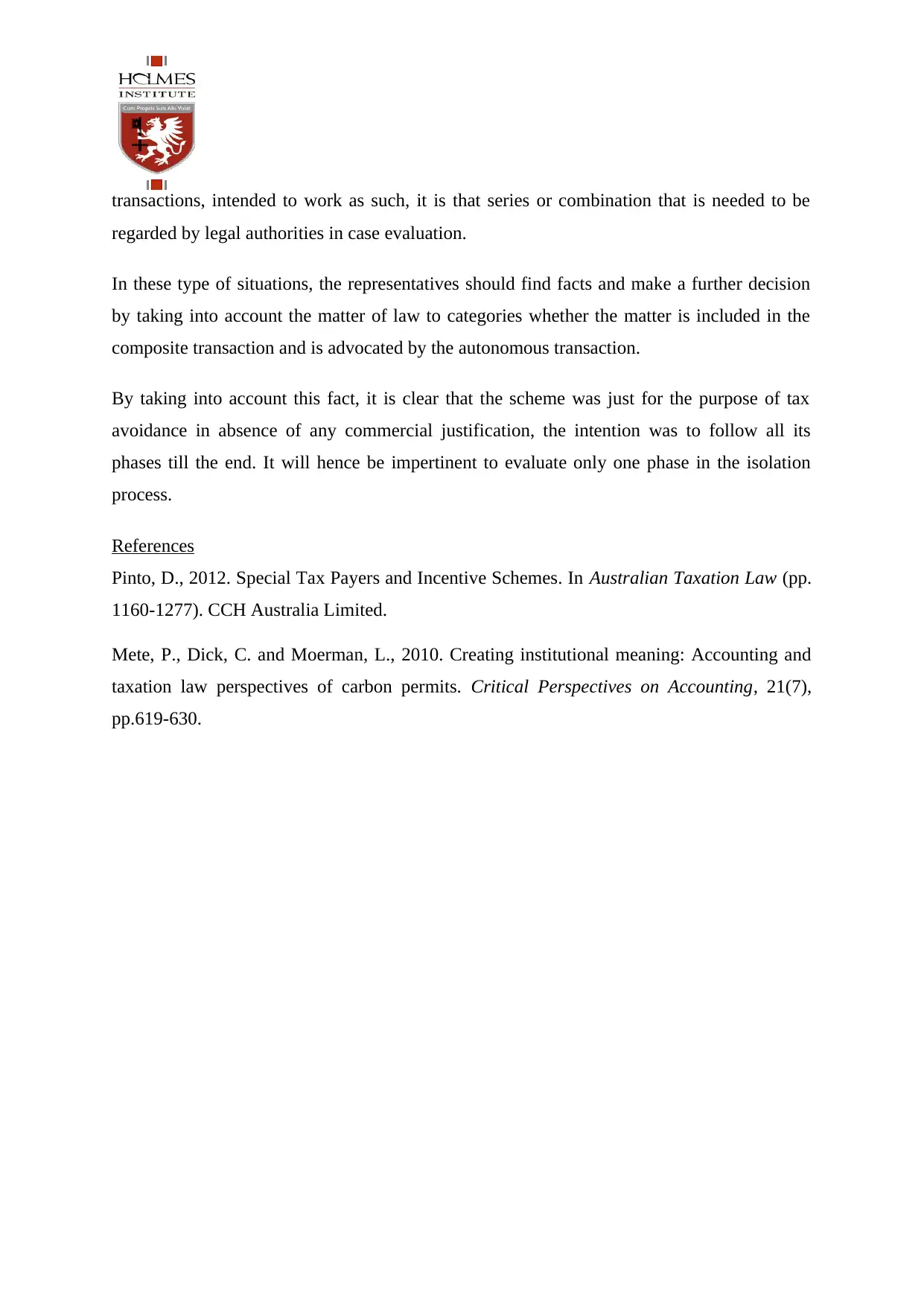
transactions, intended to work as such, it is that series or combination that is needed to be
regarded by legal authorities in case evaluation.
In these type of situations, the representatives should find facts and make a further decision
by taking into account the matter of law to categories whether the matter is included in the
composite transaction and is advocated by the autonomous transaction.
By taking into account this fact, it is clear that the scheme was just for the purpose of tax
avoidance in absence of any commercial justification, the intention was to follow all its
phases till the end. It will hence be impertinent to evaluate only one phase in the isolation
process.
References
Pinto, D., 2012. Special Tax Payers and Incentive Schemes. In Australian Taxation Law (pp.
1160-1277). CCH Australia Limited.
Mete, P., Dick, C. and Moerman, L., 2010. Creating institutional meaning: Accounting and
taxation law perspectives of carbon permits. Critical Perspectives on Accounting, 21(7),
pp.619-630.
regarded by legal authorities in case evaluation.
In these type of situations, the representatives should find facts and make a further decision
by taking into account the matter of law to categories whether the matter is included in the
composite transaction and is advocated by the autonomous transaction.
By taking into account this fact, it is clear that the scheme was just for the purpose of tax
avoidance in absence of any commercial justification, the intention was to follow all its
phases till the end. It will hence be impertinent to evaluate only one phase in the isolation
process.
References
Pinto, D., 2012. Special Tax Payers and Incentive Schemes. In Australian Taxation Law (pp.
1160-1277). CCH Australia Limited.
Mete, P., Dick, C. and Moerman, L., 2010. Creating institutional meaning: Accounting and
taxation law perspectives of carbon permits. Critical Perspectives on Accounting, 21(7),
pp.619-630.
⊘ This is a preview!⊘
Do you want full access?
Subscribe today to unlock all pages.

Trusted by 1+ million students worldwide
1 out of 14
Related Documents
Your All-in-One AI-Powered Toolkit for Academic Success.
+13062052269
info@desklib.com
Available 24*7 on WhatsApp / Email
![[object Object]](/_next/static/media/star-bottom.7253800d.svg)
Unlock your academic potential
Copyright © 2020–2025 A2Z Services. All Rights Reserved. Developed and managed by ZUCOL.





